Beyond joseki
Joseki: a fixed sequence of moves resulting in a fair local outcome for both players.
There are several stages related to one's Go improvement and joseki:
- Knowing no joseki at all.
- Learning joseki by heart: knowing what joseki are possible in each position.
- Understanding the meaning of joseki: knowing what joseki to choose that best fits the whole board.
- Beyond joseki: knowing when not to play joseki - as if it wasn't hard enough to learn joseki in the first place...
I'll just illustrate stage 4, "beyond joseki", based on the famous "taisha joseki", with examples from the English Go literature.
Example 1
This example is from the "Lessons in the Fundamentals of Go" book (by Toshiro Kageyama), chapter 1.
Diagram 1 shows the position from a game between Kageyama and Kajiwara. Kageyama sensei is White, and they are in the middle of the taisha joseki in the upper-left. Normally White blocks with A next, and Black plays hane at B, and a complicated fight follows.
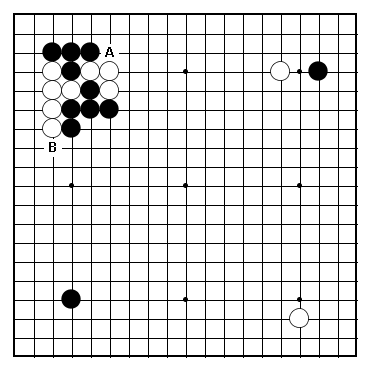 Dia. 1
Dia. 1
White decided not to follow the joseki, though, but sacrificed the 3 stones on the upper side and played hane with 22 in diagram 2, and the next few moves are the ones showed in this diagram.
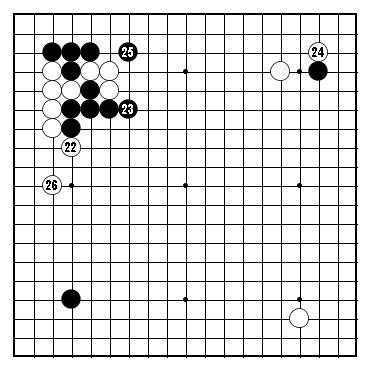 Dia. 2
Dia. 2
Locally this is a big loss for White (the book quotes Yamabe sensei commenting after the game: "How could anybody be so dumb as to hane at 22 and let Black extend to a point like 23?"), but globally this loss made sense for White, since he played several moves elsewhere. Another professional, Sugiuchi sensei, was of the opinion that this was "a new pattern that gives a fair result".
Example 2
This example is from the "Beauty and the Beast - Exquisite Play and Go Theory" book
Black is Ushinohama Satsuo from Japan, and white is Wu Songsheng from China - this is a game from a China-Japan exchange match in 1978. Diagram 3 shows that start of the game - notice another variation of the taisha joseki in the upper-left, with White to move.
White normally plays "A" to move out his 2 stones, Black presses at "B", White answers "C" on the upper side, then Black attacks from the center with "D". In this case, though, it will be unpleasant for White to have to escape on the left side - because Black has a stone in the lower left corner.
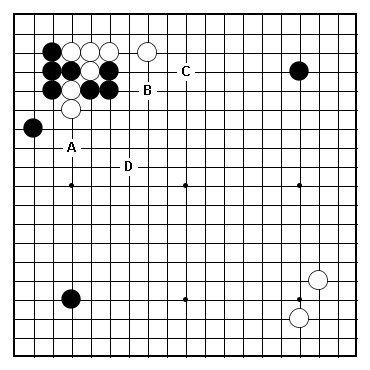 Dia. 3
Dia. 3
"Joseki no good? No problem." thinks White, and sacrifices the 2 stones in the upper left by taking large points elsewhere, as diagram 4 shows.
 Dia. 4
Dia. 4
Example 3
This example is from Go World nr. 43 - the 10th Meijin title from 1985 was played between Cho Chikun and Kobayashi Koichi. All games in Go World are normally commented, but game 2 of this match has a very special commentary: Tei Meiko, Oya Koichi and Maeda Ryoji (all young professionals at that time) commented the game together, and a reported recorded their discussion. Then he showed Takemiya sensei (Honinbo at the time) their comments, and he criticised their comments. The title of the article is "Commentary on a Commentary" and it is extremely interesting.
My attention was caught first when I saw the name of Tei Meiko sensei - since he was one of the official insei instructors while I was an insei in Japan - if you looked by chance at my insei games, you may have noticed that most of them are commented by Tei Meiko sensei. By the way, I had the chance to talk to Tei Meiko sensei by email about one month before writing this article. I asked him several questions which I intend to write a separate article about, but about joseki he said the he recommends every beginner to learn at least a few basic joseki - no problem to learn by heart, since understanding them is the hard part and that will come later.
Diagram 5 shows the fuseki in this Meijin game - and in the lower left one can see a just started taisha joseki. Black can choose between A and B next. In the game Black played A, and the reporter asked the three young professionals about the other common joseki move, Black B.
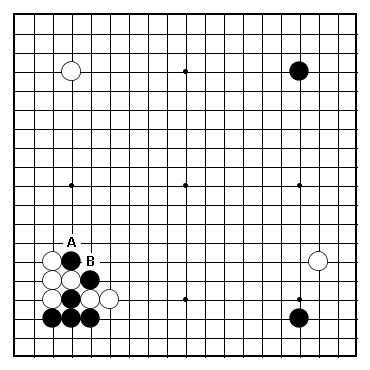 Dia. 5
Dia. 5
They show the sequence in diagram 6, the standard joseki follow-up: the reason why White doesn't like this joseki is that Black can press with move 25, which works very well not only in the lower right, but also as a leaning attack against the White group on the lower side.
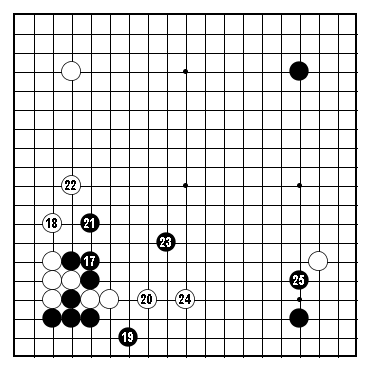 Dia. 6
Dia. 6
So why didn't Black choose B in diagram 5 to start with, if the joseki is giving him such a good position? The reason is explained by the professional commenting the game in diagram 7: White will not blindly follow the joseki but he will take the chance to play first in the lower right corner. Then he'll play 34 in diagram 7 and build thickness on the left side while sacrificing the two stones on the lower side.
 Dia. 7
Dia. 7
Read the whole Go World article - it is a unique view into how a more senior professional views a young professional's comments. If the printed issue number 43 is not available for backorder anymore from kiseido.com, you can order the digital (PDF format) version from kiseidodigital.com.
Warning
By reading this article one shouldn't get the wrong idea that taisha is a joseki that one should normally play tenuki in - on the contrary, taisha is one of the most complicated joseki involving a fight between many groups, and therefore tenuki is rare. The purpose of this article was only to show the flexibility in the thinking process of professional players - and how we should all learn from this and try to choose our moves with the whole board in mind, not just because some move is joseki.
Conclusion
- The best move is not necessary a joseki, but whatever makes sense in the context of the whole board.
- It is definitely good to know joseki, but we shouldn't become "joseki slaves" - we should make sure we keep an open mind and consider non-joseki moves as well.
- Departing from a joseki by playing tenuki is very closely related to sacrifices - giving up local stones for the sake of builing some global advantage.
Resources
"The Great Joseki Debates" by Honda Kunihisa - an excellent series of articles about how to choose joseki with the whole board in mind.
The Sensei's Library page on the "Taisha Joseki".
